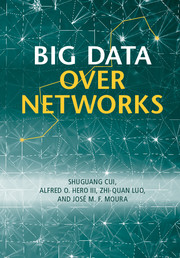Refine search
Actions for selected content:
48202 results in Computer Science
Digital health in the age of The Infinite Network
-
- Journal:
- APSIPA Transactions on Signal and Information Processing / Volume 5 / 2016
- Published online by Cambridge University Press:
- 28 March 2016, e5
- Print publication:
- 2016
-
- Article
-
- You have access
- Open access
- HTML
- Export citation
Counting and generating terms in the binary lambda calculus*
- Part of
-
- Journal:
- Journal of Functional Programming / Volume 25 / 2015
- Published online by Cambridge University Press:
- 29 December 2015, e24
-
- Article
-
- You have access
- Export citation
Isomorphism theorems between models of mixed choice
-
- Journal:
- Mathematical Structures in Computer Science / Volume 27 / Issue 6 / September 2017
- Published online by Cambridge University Press:
- 28 December 2015, pp. 1032-1067
-
- Article
- Export citation
The Multiple-Orientability Thresholds for Random Hypergraphs†
- Part of
-
- Journal:
- Combinatorics, Probability and Computing / Volume 25 / Issue 6 / November 2016
- Published online by Cambridge University Press:
- 28 December 2015, pp. 870-908
-
- Article
- Export citation
PES volume 30 issue 1 Cover and Back matter
-
- Journal:
- Probability in the Engineering and Informational Sciences / Volume 30 / Issue 1 / January 2016
- Published online by Cambridge University Press:
- 23 December 2015, pp. b1-b2
-
- Article
-
- You have access
- Export citation
PES volume 30 issue 1 Cover and Front matter
-
- Journal:
- Probability in the Engineering and Informational Sciences / Volume 30 / Issue 1 / January 2016
- Published online by Cambridge University Press:
- 23 December 2015, pp. f1-f2
-
- Article
-
- You have access
- Export citation
NWS volume 3 issue 4 Cover and Back matter
-
- Journal:
- Network Science / Volume 3 / Issue 4 / December 2015
- Published online by Cambridge University Press:
- 22 December 2015, pp. b1-b2
-
- Article
-
- You have access
- Export citation
NWS volume 3 issue 4 Cover and Front matter
-
- Journal:
- Network Science / Volume 3 / Issue 4 / December 2015
- Published online by Cambridge University Press:
- 22 December 2015, pp. f1-f3
-
- Article
-
- You have access
- Export citation
ROB volume 34 issue 2 Cover and Back matter
-
- Article
-
- You have access
- Export citation
FROM STENIUS’ CONSISTENCY PROOF TO SCHÜTTE’S CUT ELIMINATION FOR ω-ARITHMETIC
-
- Journal:
- The Review of Symbolic Logic / Volume 9 / Issue 1 / March 2016
- Published online by Cambridge University Press:
- 22 December 2015, pp. 1-22
- Print publication:
- March 2016
-
- Article
- Export citation
PROPOSITIONAL CONTINGENTISM
-
- Journal:
- The Review of Symbolic Logic / Volume 9 / Issue 1 / March 2016
- Published online by Cambridge University Press:
- 22 December 2015, pp. 123-142
- Print publication:
- March 2016
-
- Article
-
- You have access
- Export citation
ROB volume 34 issue 2 Cover and Front matter
-
- Article
-
- You have access
- Export citation
Triadic analysis of affiliation networks
-
- Journal:
- Network Science / Volume 3 / Issue 4 / December 2015
- Published online by Cambridge University Press:
- 22 December 2015, pp. 480-508
-
- Article
- Export citation
Manipulative Waiters with Probabilistic Intuition
- Part of
-
- Journal:
- Combinatorics, Probability and Computing / Volume 25 / Issue 6 / November 2016
- Published online by Cambridge University Press:
- 21 December 2015, pp. 823-849
-
- Article
- Export citation
Local Maxima of Quadratic Boolean Functions
- Part of
-
- Journal:
- Combinatorics, Probability and Computing / Volume 25 / Issue 4 / July 2016
- Published online by Cambridge University Press:
- 21 December 2015, pp. 633-640
-
- Article
- Export citation
THE RUNNING MAXIMUM OF A LEVEL-DEPENDENT QUASI-BIRTH-DEATH PROCESS
-
- Journal:
- Probability in the Engineering and Informational Sciences / Volume 30 / Issue 2 / April 2016
- Published online by Cambridge University Press:
- 21 December 2015, pp. 212-223
-
- Article
- Export citation

Big Data over Networks
-
- Published online:
- 18 December 2015
- Print publication:
- 14 January 2016
Preface
-
-
- Book:
- Design and Deployment of Small Cell Networks
- Published online:
- 05 December 2015
- Print publication:
- 17 December 2015, pp xv-xvi
-
- Chapter
- Export citation
14 - The art of deploying small cells: field trial experiments, system design, performance prediction, and deployment feasibility
-
-
- Book:
- Design and Deployment of Small Cell Networks
- Published online:
- 05 December 2015
- Print publication:
- 17 December 2015, pp 338-362
-
- Chapter
- Export citation


